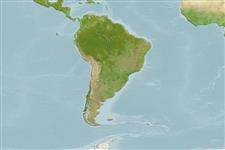Common names from other countries
Environment: milieu / climate zone / depth range / distribution range
Οικολογία
; εύρος βάθους 0 - 15 m (Ref. 105490). Subtropical; 16°S - 41°S, 75°W - 70°W
Southeast Pacific: Peru and Chile.
Length at first maturity / Μέγεθος / Βάρος / Age
Maturity: Lm ? range ? - ? cm
Occurs in the lowermost intertidal zone and immediate subtidal zone to 15 m on upper surfaces of rocks. In deep tide pools at low tide (Ref. 105490). Inhabits sublittoral rocky zone (Refs. 106267, 106270). Found on matrices of the tunicate Pyura praeputialis (Ref. 66198). Members of the Family Fissurellidae are herbivorous, grazing on algae (Ref. 104247).
Life cycle and mating behavior
Γεννητική Ωρίμανση | Αναπαραγωγή | Γεννοβολία | Αβγά | Γονιμότητα | Προνύμφες
Members of the order Patellogastropoda are mostly gonochoric and broadcast spawners. Life cycle: Embryos develop into planktonic trocophore larvae and later into juvenile veligers before becoming fully grown adults.
Servicio Nacional de Pesca y Acuicultura. 2011. (Ref. 90098)
IUCN Red List Status (Ref. 130435)
CITES status (Ref. 108899)
Not Evaluated
Not Evaluated
Threat to humans
Harmless
Human uses
αλιεία: Εμπορικό(ά)
| FishSource |
Εργαλεία
Περισσότερες πληροφορίες
Age/SizeΑύξησηLength-weightLength-lengthΜορφολογίαΠρονύμφεςΑφθονία
Διαδικτυακές πηγές
Estimates based on models
